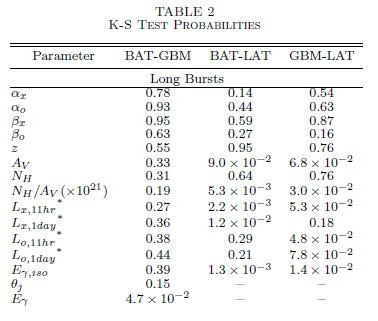Racusin 2011 Fermi和Swift暴的余辉统计
主要内容:
把这些暴拿过来一起统计,有多个量。
精彩摘抄:
文章信息:
· Find Similar Abstracts (with default settings below) - · arXiv e-print (arXiv:1106.2469)
- · References in the Article
- · Also-Read Articles (Reads History)
- ·
- · Translate This Page
| Title: | Fermi and Swift Gamma-Ray Burst Afterglow Population Studies | |
| Authors: | Racusin, J. L.; Oates, S. R.; Schady, P.; Burrows, D. N.; de Pasquale, M.; Donato, D.; Gehrels, N.;Koch, S.; McEnery, J.; Piran, T.; Roming, P.; Sakamoto, T.; Swenson, C.; Troja, E.; Vasileiou, V.;Virgili, F.; Wanderman, D.; Zhang, B. | |
| Publication: | eprint arXiv:1106.2469 | |
| Publication Date: | 06/2011 | |
| Origin: | ARXIV | |
| Keywords: | Astrophysics - High Energy Astrophysical Phenomena | |
| Comment: | 13 pages, 11 figures, Accepted for publication in ApJ | |
| Bibliographic Code: | 2011arXiv1106.2469R |
Abstract
The new and extreme population of GRBs detected by Fermi-LAT shows several new features in high energy gamma-rays that are providing interesting and unexpected clues into GRB prompt and afterglow emission mechanisms. Over the last 6 years, it has been Swift that has provided the robust dataset of UV/optical and X-ray afterglow observations that opened many windows into components of GRB emission structure. The relationship between the LAT detected GRBs and the well studied, fainter, less energetic GRBs detected by Swift-BAT is only beginning to be explored by multi-wavelength studies. We explore the large sample of GRBs detected by BAT only, BAT and Fermi-GBM, and GBM and LAT, focusing on these samples separately in order to search for statistically significant differences between the populations, using only those GRBs with measured redshifts in order to physically characterize these objects. We disentangle which differences are instrumental selection effects versus intrinsic properties, in order to better understand the nature of the special characteristics of the LAT bursts.| Bibtex entry for this abstract Preferred format for this abstract (see Preferences) |













